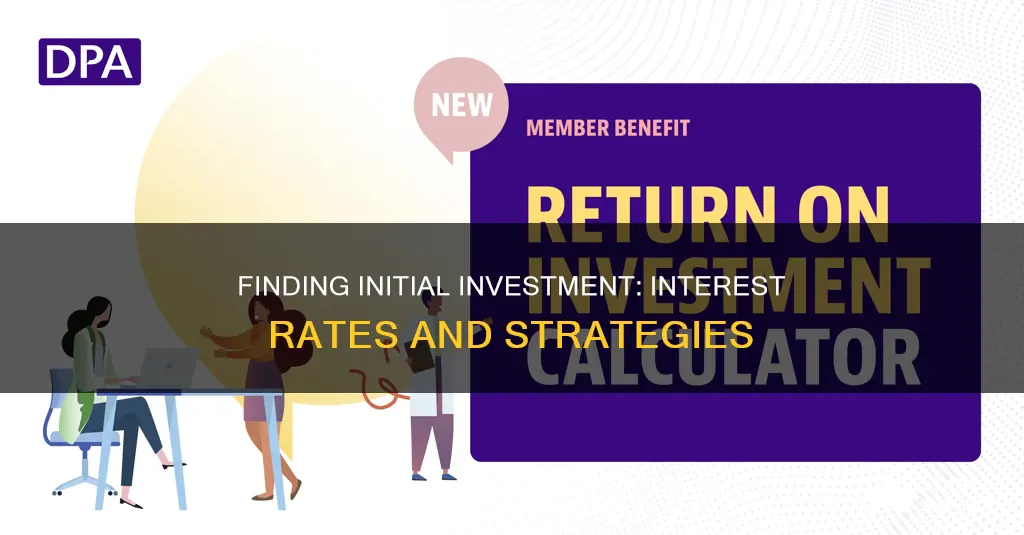
Calculating an initial investment is a crucial step in financial planning, whether for short-term goals like home repairs or long-term aspirations like retirement. To determine the initial investment, individuals must identify their financial objectives and calculate the required rate of return. This can be achieved through initial investment calculators or formulas that consider factors such as the future amount of money desired, the present dollar amount, the annual interest rate, and the duration of the investment. Understanding compound interest and nominal interest rates is also essential when dealing with varying compounding periods. By utilising these tools and concepts, individuals can make informed decisions about their investments and work towards achieving their financial goals.
| Characteristics | Values |
|---|---|
| Formula for initial investment | F = P (1 + i)n |
| Where | F = future amount of money |
| P = present dollar amount or initial investment | |
| i = annual interest rate (expressed as a decimal) | |
| n = number of years the initial investment will be paying interest | |
| Example | If your goal is to have $2,500 (F) after 10 years (n) at an interest rate of 5% (i), you must begin with an initial investment of $1,534.78 |
| If you start with an initial investment of $1,000 at an annual interest rate of 5%, the value of the investment after 10 years will be $1,628.89 | |
| Compound interest | If the interest is compounded semi-annually with a periodic multiplier of 1.08, an initial investment of P dollars will, by the end of the 12th half-year, grow to become \(P(1.08)^{12} \approx P(2.518)\) |
| The interest earned during those 12 half-years would be \(P(1.08)^{12} – P\) | |
| When the annual interest rate is given but the compounding period is not a year (e.g. compounded monthly or weekly), that interest rate is called the nominal interest rate (which is not the real interest rate) | |
| Calculators | IRR (internal rate of return) helps you to calculate the interest rate (also known as a discount rate) you would need to see on a given investment in order to break even |
| Initial investment calculator for IRR and NPV can help clarify how you hope to spend your money |
What You'll Learn

Calculating an initial investment
To calculate an initial investment, you need to identify your financial goal and calculate your likely rate of return.
For example, if your goal is to have $2,500 after 10 years at an interest rate of 5%, you must begin with an initial investment of $1,534.78. This can be calculated using the formula P = F / (1+i) n, where F represents the future amount of money, P the present dollar amount or initial investment, i the annual interest rate (expressed as a decimal) and n the number of years the initial investment will be paying interest.
If you start with an initial investment of $1,000 at an annual interest rate of 5%, the value of the investment after 10 years will be $1,628.89. This can be calculated using the formula F = P (1 + i)n, where F represents the future amount of money, P the present dollar amount or initial investment, i the annual interest rate (expressed as a decimal) and n the number of years the initial investment will be paying interest.
An initial investment calculator for IRR and NPV can also help clarify how you hope to spend your money. IRR, or internal rate of return, helps you to calculate the interest rate (also known as a discount rate) you would need to see on a given investment in order to break even.
Understanding Simple Interest Rates: Calculating Your Investment Returns
You may want to see also

Compound interest
To find the initial investment and interest rate, you must first identify your financial goal and calculate your likely rate of return. You can then use an initial investment calculator or a formula to help meet your financial goals.
The formula for an initial investment calculator with compound interest is F = P (1 + i)n, where F represents the future amount of money, P the present dollar amount or initial investment, i the annual interest rate (expressed as a decimal) and n the number of years the initial investment will be paying interest.
For example, if you start with an initial investment of $1,000, at an annual interest rate of 5%, the value of the investment after 10 years will be $1,628.89. If your goal is to have $2,500 after 10 years at an interest rate of 5%, you must begin with an initial investment of $1,534.78.
When the annual interest rate is given but the compounding period is not a year (e.g. compounded monthly or weekly), that interest rate is called the nominal interest rate (which is not the real interest rate). In this case, it is up to you to figure out the periodic interest rate and the associated periodic multiplier. For example, if the interest is compounded semi-annually with a periodic multiplier of 1.08, then an initial investment of P dollars will, by the end of the 12th half-year, grow to become $P(1.08)^{12} \approx P(2.518)$.
Investment Interest Expense: What Can Be Deducted?
You may want to see also

Setting financial goals
To work out how much money you need to invest, you should first identify your financial goal, then calculate your likely rate of return. You can use an initial investment calculator or a formula to help meet your financial goals. The formula for an initial investment calculator with compound interest is F = P (1 + i)n, where F represents the future amount of money, P the present dollar amount or initial investment, i the annual interest rate (expressed as a decimal) and n the number of years the initial investment will be paying interest.
For example, if you want to have $2,500 after 10 years at an interest rate of 5%, you must begin with an initial investment of $1,534.78. You can also use an initial investment calculator for IRR (internal rate of return) to calculate the interest rate you would need to see on a given investment in order to break even.
If you start with an initial investment of $1,000 at an annual interest rate of 5%, the value of the investment after 10 years will be $1,628.89. However, if the interest is compounded semi-annually with a periodic multiplier of 1.08, then an initial investment of P dollars will, by the end of the 12th half-year, grow to become $P(1.08)^{12} \approx P(2.518)$. That is, the amount at the end of the 12th half-year will become $2.518 times the original amount, in which case, the interest earned during those 12 half-years would be $P(1.08)^{12} – P$.
Understanding the Power of Compounding: Doubling Investments
You may want to see also

Calculating the rate of return
To calculate the rate of return on an investment, you first need to identify your financial goal. This could be a short-term goal, such as saving for a holiday, or a long-term goal, such as paying off your mortgage. Once you have a clear goal in mind, you can calculate your likely rate of return using an initial investment calculator or a formula.
The formula for an initial investment calculator with compound interest is F = P (1 + i)n, where F represents the future amount of money, P the present dollar amount or initial investment, i the annual interest rate (expressed as a decimal) and n the number of years the initial investment will be paying interest.
For example, if you start with an initial investment of $1,000 at an annual interest rate of 5%, the value of the investment after 10 years will be $1,628.89. If your goal is to have $2,500 after 10 years at an interest rate of 5%, you must begin with an initial investment of $1,534.78.
It's important to note that when the annual interest rate is given but the compounding period is not a year (e.g. monthly or weekly compounding), the interest rate is called the nominal interest rate. In this case, you would need to calculate the periodic interest rate and the associated periodic multiplier.
Investing Strategies for Rising Interest Rates: Where to Focus
You may want to see also

Using an initial investment calculator
To find an initial investment and interest rate, you should first identify your financial goal. For example, you might want to save enough money to fix the foundation of your house, or to pay off your mortgage. These goals should be SMART: specific, measurable, attainable, relevant and time-bound.
Once you have a goal in mind, you can calculate your likely rate of return. You can do this with an initial investment calculator, or by using a formula. The formula for an initial investment calculator with compound interest is F = P (1 + i)n, where F represents the future amount of money, P the present dollar amount or initial investment, i the annual interest rate (expressed as a decimal) and n the number of years the initial investment will be paying interest.
If you want to start with a desired future amount of money, you can flip the formula to be P = F / (1+i) n. For example, if your goal is to have $2,500 after 10 years at an interest rate of 5%, you must begin with an initial investment of $1,534.78.
It's important to note that when the annual interest rate is given but the compounding period is not a year (e.g. it's compounded monthly or weekly), that interest rate is called the nominal interest rate, and it's up to you to figure out the periodic interest rate and the associated periodic multiplier.
Robinhood's Interest Policy: What Investors Need to Know
You may want to see also
Frequently asked questions
The formula for an initial investment calculator with compound interest is F = P (1 + i)n, where F represents the future amount of money, P the present dollar amount or initial investment, i the annual interest rate (expressed as a decimal) and n the number of years the initial investment will be paying interest.
If you wish to start with a desired F, you can flip the formula to be P = F / (1+i)n.
If you start with an initial investment of $1,000, at an annual interest rate of 5%, the value of the investment after 10 years will be $1,628.89.
To determine how much money you wish to invest in a given fund, begin by identifying the financial goal you hope to reach, then calculate your likely rate of return.
IRR, or internal rate of return, helps you to calculate the interest rate (also known as a discount rate) you would need to see on a given investment in order to break even.







